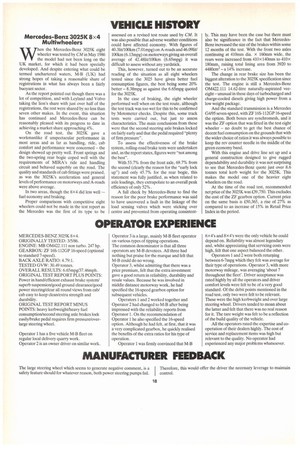VEHICLE HISTORY
Page 126

If you've noticed an error in this article please click here to report it so we can fix it.
Mercedes-Benz 3025K 8x4 Multiwheelers
When the Mercedes-Benz 3025K eight wheeler was tested by CM in May 1986 the model had not been long on the UK market, for which it had been specially developed. And despite entering what could be termed unchartered waters, M-B (UK) had strong hopes of taking a reasonable share of registrations in what has always been a fairly buoyant sector. As the report pointed out though there was a lot of competition, and with Leyland and Volvo taking the lion's share with just over half of the registrations, the rest were shared by no less than seven other makes. In the event, this situation has continued and Mercedes-Benz can be reasonably pleased with its progress to date in achieving a market share approaching 4%. On the road test, the 3025K gave a workmanlike if unspectacular performance in most areas and as far as handling, ride, cab comfort and performance were concerned the design showed up pretty well. Front springs and the two-spring rear bogie coped well with the requirements of MIRA's ride and handling circuit and behaved superbly on the road. The quality and standards of cab fittings were praised, as was the 3025K's acceleration and general levels of performance on motorways and A-roads were above average. In two areas, though the 8x4 did less well -fuel economy and braking. Proper comparisons with competitive eight wheelers could not be made in the test report as the Mercedes was the first of its type to be assessed on a revised test route used by CM. It was also possible that adverse weather conditions could have affected economy. With figures of 40.31it/1001rm (7.01mpg) on A-roads and 46.091it/ 100km (6.13mpg) on motorways giving an overall average of 42.481:W100km (6.65mpg) it was difficult to assess without any yardstick. This, however, turned out to be an accurate reading of the situation as all eight wheelers tested since the 3025 have given better fuel consumption figures, the best being some 20% better 8.38mpg as against the 6.65mpg quoted for the 3025K.
In the case of braking, the eight wheeler performed well when on the test route, although the test track was too wet for this to be confirmed by Motometer checks. Despite this, some track tests were carried out, but just to assess characteristics. The main conclusions from these were that the second steering axle brakes locked on fairly early and that the pedal required "plenty of firm pressure".
To assess the effectiveness of the brake system, rolling-road brake tests were undertaken and, as the report states, figures were "not among the best".
With 53.7% from the front axle, 69.7% from the second (clearly the reason for the "early lock up") and only 45.7% for the rear bogie, this statement was fully justified, as when related to axle loadings, they extrapolate to an overall peak efficiency of only 52%. A full check by Mercedes-Benz to find the reason for the poor brake performance was said to have uncovered a fault in the linkage of the load sensing valves which were sticking over centre and prevented from operating consistent ly. This may have been the case but there must also be significance in the fact that MercedesBenz increased the size of the brakes within some 12 months of the test. With the front two axles continuing at 410mm din. x 160nun wide, the rears were increased from 410 x 140mm to 410x 180mm, raising total lining area from 3920 to 4480em2a 14% increase.
The change in rear brake size has been the biggest alteration to the 3025K specification since the test. The engine is still a Mercedes-Benz 0M422.111 14.62-litre naturally-aspirated veeeight unusual in these days of turbocharged and charge-cooled diesels giving high power from a low weight package. And the standard transmission is a Mercedes 04/95 seven-speed, with ZF 16S-112GP 16-speed the option. Both boxes are synchromesh, and it was the ZF option that was fitted in the test eight wheeler no doubt to get the best chance of decent fuel consumption on the grounds that with the wider choice of ratios it was always possible to keep the rev counter needle in the middle of the green economy band. With this engine and drive line set up and a general construction designed to give rugged dependability and durability it was not surprising to see that Mercedes-Benz quote just over 8.6 tonnes total kerb weight for the 3025K. This makes the model one of the heavier eight wheelers on the road.
At the time of the road test, recommended net price of the 3025K was £39,750. This excludes the cost of the ZF gearbox option. Current price on the same basis is £50,365, a rise of 27% as compared to an increase of 15% in Retail Price Index in the period.












































































































































